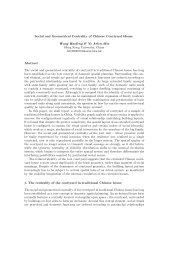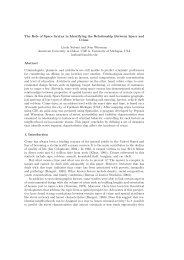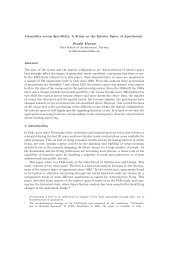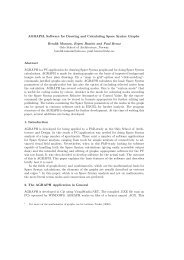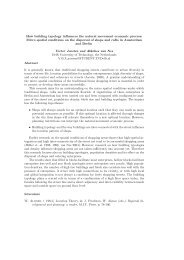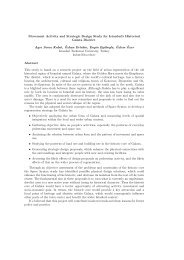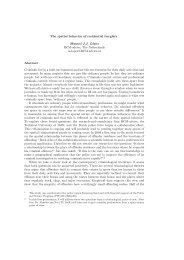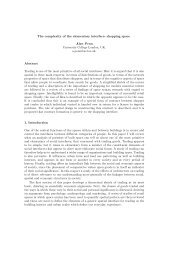High Resolution Analysis of Crime Patterns in Urban Street Networks
High Resolution Analysis of Crime Patterns in Urban Street Networks
High Resolution Analysis of Crime Patterns in Urban Street Networks
Create successful ePaper yourself
Turn your PDF publications into a flip-book with our unique Google optimized e-Paper software.
<strong>High</strong> <strong>Resolution</strong> <strong>Analysis</strong> <strong>of</strong> <strong>Crime</strong> <strong>Patterns</strong> <strong>in</strong> <strong>Urban</strong> <strong>Street</strong> <strong>Networks</strong>: an <strong>in</strong>itialstatistical sketch from an ongo<strong>in</strong>g study <strong>of</strong> a London borough 467we see that while all three fall consistently with <strong>in</strong>creased numbers <strong>of</strong> dwell<strong>in</strong>gs, wherenumbers <strong>of</strong> dwell<strong>in</strong>gs are small, segments with non-residential have much higher burglaryrates, but with <strong>in</strong>creas<strong>in</strong>g number <strong>of</strong> dwell<strong>in</strong>gs the three trends converge as the ratio <strong>of</strong>residential to non-residential <strong>in</strong>creases for the l<strong>in</strong>es with either 1-4 or any number <strong>of</strong> nonresidential.The differences do not quite disappear, but it suggests that it is the degree towhich residential units outnumber non-residential that is critical. It also po<strong>in</strong>ts aga<strong>in</strong> tothe high vulnerability <strong>of</strong> small numbers <strong>of</strong> dwell<strong>in</strong>gs <strong>in</strong> strongly non-residential areas.We see then that, for burglary, the relations between spatial and land use factors, withthe implications <strong>of</strong> both for movement, are complex. Integration and segment connectivityare beneficial <strong>in</strong> more grid-like residential areas, but not <strong>in</strong> high street areas wheredwell<strong>in</strong>gs are sparse and vulnerable. But this does not mean that mix<strong>in</strong>g uses simply<strong>in</strong>creases vulnerability. This is largely a function <strong>of</strong> the ratio <strong>of</strong> dwell<strong>in</strong>gs to other uses.Where the ratio <strong>of</strong> dwell<strong>in</strong>gs to other uses is high, the <strong>in</strong>creased risk from other uses issmall, though not negligible.9. Primary risk band analysis <strong>of</strong> robberyWhat then <strong>of</strong> robbery? We must first establish what we mean by primary risk. Whereasburglary is a crime aga<strong>in</strong>st a fixed asset, whose numbers on segments rema<strong>in</strong> constant,robbery is usually a crime aga<strong>in</strong>st a mov<strong>in</strong>g person. This suggests two primary risk factors.The first is the length <strong>of</strong> time a mov<strong>in</strong>g person spends on a segment, and we can assumethis will be, on average, a function <strong>of</strong> its length. We can call this time risk. The second isthe number <strong>of</strong> potential victims mov<strong>in</strong>g on the segment. Risk <strong>of</strong> be<strong>in</strong>g selected as a targetreduces with <strong>in</strong>creases number <strong>of</strong> people on the segment. We can call this people risk.Both survive the randomness test. Random assignment <strong>of</strong> hypothetical robbery po<strong>in</strong>ts toa map <strong>of</strong> urban routes (we do not need to consider the width <strong>of</strong> streets for this analysis,as movement take the general form <strong>of</strong> a th<strong>in</strong> l<strong>in</strong>ear trace) will eventually produce morepo<strong>in</strong>ts on longer segments. Select<strong>in</strong>g randomly mov<strong>in</strong>g people randomly as victims willalso lead to higher number <strong>of</strong> victims on more populated segments, though <strong>of</strong> course asNewman remarks above, the rate will be lower. The same arguments that prohibit the use<strong>of</strong> segment by segment counts or rates then also prohibit the use <strong>of</strong> segment by segmentrobbery counts or rates. We will deal with the two k<strong>in</strong>ds <strong>of</strong> primary risk factor <strong>in</strong> order,tak<strong>in</strong>g length first as this is measurable from a plan, whereas movement rates are not.We first show that segment length is <strong>in</strong>deed a primary risk factor. We aggregate therobbery data <strong>in</strong>to 45 segment length bands, <strong>in</strong>itially at 5 metre <strong>in</strong>tervals up to 100, then 10to 250 metres and the <strong>in</strong>creas<strong>in</strong>g by larger <strong>in</strong>terval to ma<strong>in</strong>ta<strong>in</strong> total band length between7000 and 26000 metres. We then count the number <strong>of</strong> robberies with<strong>in</strong> each band anddivide it by the number <strong>of</strong> segments. We f<strong>in</strong>d the rate rises consistently with <strong>in</strong>creas<strong>in</strong>glength (Figure 232a).This shows that the time spent on a segment <strong>in</strong> mov<strong>in</strong>g through it is <strong>in</strong>deed a primaryrisk factor. However if we normalise to robberies per metre for bands by tak<strong>in</strong>g totalrobberies per band and divid<strong>in</strong>g <strong>in</strong>to total band length, we do not f<strong>in</strong>d, as we did withburglary, a consistent fall <strong>in</strong> rate but a sharp rise followed by and equally sharp fall, withanother rise and fall <strong>in</strong> the higher ranges (Figure 232b).How can this be expla<strong>in</strong>ed? Very simply, it turns out. If we recalculate the bands asthose without non-residential uses and those with non-residential uses, we f<strong>in</strong>d that thebands with zero non-residential uses do <strong>in</strong>deed fall consistently with <strong>in</strong>creas<strong>in</strong>g length, and



